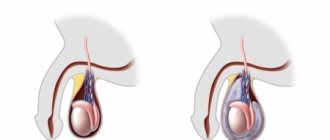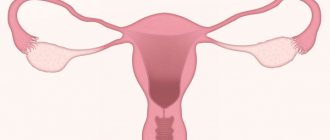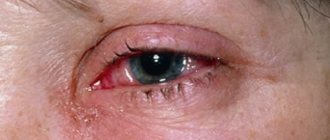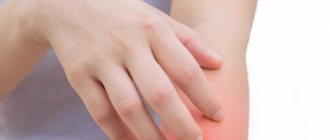Urologist
Mkrtchyan
Karen Gagikovich
13 years of experience
Candidate of Medical Sciences, member of the European Association of Urology and the Russian Society of Oncourologists
Make an appointment
Orchitis in men is an inflammatory process in the testicular tissues, which is caused by a bacterial or viral nature, as well as trauma to the testicles. The risk group includes men of all ages. Orchitis in men often appears at the age of peak sexual activity. The cause of orchitis at this age lies in the greatest likelihood of infection. In childhood, orchitis most often has a viral nature. Infection with sexually transmitted diseases, one way or another, is accompanied by inflammation leading to orchitis. Orchitis in adult men over 50 years of age develops against the background of dysfunction of the genitourinary system.
Symptoms and signs of orchitis
Symptoms of orchitis in the classical manifestation depend on the severity of the pathological processes and the cause of the development of the disease. Common symptoms of orchitis:
- weakness;
- high fever and chills;
- headache;
- muscle aches.
Acute orchitis, as a rule, develops rapidly, literally in a couple of days.
Symptoms of testicular orchitis:
- increasing size;
- sharp pain decreases when lying down;
- hyperemia of the skin over the affected testicle;
- severe swelling that does not allow palpation of internal structures;
- copious secretion of secretion that has an unpleasant odor and a specific yellow-green tint;
- enlarged lymph nodes in the groin are likely;
- dysfunction of urination - pain, frequency of urges, etc.
Chronic orchitis has stable symptoms. Symptoms of orchitis in chronic men:
- increased temperature during exacerbations;
- the presence of nagging and aching pain that intensifies during physical activity, sexual intercourse and defecation;
- pain is localized in the groin, perineum and testicle;
- the presence of blood in the semen indicates the onset of complications.
Testicular orchitis accompanies epidemic mumps. The first symptoms of orchitis in men against the background of a mumps epidemic are general weakness, fever and chills, difficulty swallowing and swelling in the ear area. In this case, irreversible damage to the testicle often occurs.
Symptoms of epididymitis in men
Signs of an acute form of epididymitis include the following symptoms:
- Body temperature rises up to 38–39 °C
- Headaches, vomiting, lethargy, decreased ability to work and general weakness of the whole body.
- Inflammation and swelling of the scrotum, redness of the dermis.
- Consolidation and significant enlargement of the appendages and other parts of the scrotum where it is located.
- Pain when urinating, there may be blood in the urine.
- Severe pain in the appendages can be on one side or on both sides (depending on whether both testicles are affected by epididymitis or only one), the pain can radiate to other parts of the body such as the perineum, lower back and abdomen.
Reference! When moving or palpating the affected and inflamed organ, pain appears in the scrotum area, which becomes stronger, and can also radiate to the side or abdomen, depending on the side where the disease has formed).
The symptoms of subacute epididymitis are a little similar to acute epididymitis, but there are still differences. It is not as pronounced as acute (the pain is moderate, there is swelling, but it is insignificant, the enlargement of the scrotum is less noticeable, etc.). The temperature rises, but less than in the acute form, around 37.1–38 °C, and a decrease in temperature can occur after a fairly long period of time.
The most dangerous is chronic epididymitis, because with it the body temperature does not rise, the pain is insignificant, one appendage or both at once moderately enlarges and thickens.
Causes of occurrence and development
Inflammation of the testicles has a multifactorial nature. There is a possibility of developing testicular orchitis due to infection with bacteria and viruses, while taking medications, due to an unknown cause, and so on.
In childhood, the bacterial nature of the disease originates in congenital anomalies or dysfunctions due to the accumulation of urine residues. All this contributes to the development of urinary tract infections that are prone to relapse.
All causes of testicular orchitis in men are divided into several groups:
- viral infections - mumps, measles, rubella, chickenpox or Coxsackie virus, adenovirus or cytomegalovirus;
- urological pathologies - bacterial infections from neighboring inflamed organs (prostate, appendages, vesicles), as well as those entering through the blood from other foci of inflammation;
- traumatism – urological manipulations or operations, diagnostic procedures that violate the integrity of the membranes on the mucous membrane. This also includes insect or animal bites, blows and mechanical damage. This group of reasons can cause suppuration;
- sexually transmitted infections are any diseases acquired through sexual contact during a man’s sexual activity. The virus comes from the urethra only through contact with an infected person. The most common are chlamydia, mycoplasma, gonococci, trichomonas and other infections.
Causes of orchiepididymitis
- Infections that enter the epididymis through the vas deferens from the urethra. Chlamydia is the cause of acute epididymitis and orchitis in young men.
- Sudden hypothermia, which leads to deterioration of blood supply to the testicle and epididymis.
- Injuries or operations on the testicle, its epididymis and spermatic cord - post-traumatic orchiepididymitis. In this regard, after injuries to the scrotum and operations on its organs, antibiotics and anti-inflammatory drugs are often prescribed.
Routes of infection and risk factors
There are several ways of contracting orchitis, which depend on the causes of its occurrence. When infected by viruses, the infection process is hematogenous in nature. When infected with sexually transmitted diseases, the only route of infection is contact.
Risk factors for developing the disease are:
- HIV status;
- diabetes;
- severe form of infectious diseases;
- other factors of immunosuppression;
- taking hormones, chemotherapy or immunosuppressants and others.
General information
Orchitis (syn. testicular inflammation) is classified as an acute/chronic inflammatory process in testicular tissues.
ICD-10 code: N45.9. Inflammation of the testicle in men can occur either alone or in combination with inflammation of the epididymis (epididymo-orchitis). The combination of orchitis with epididymitis occurs in 80-85% of cases. The majority of lesions occur in one testicle, while bilateral lesions account for 15-20%. With orchitis, diffuse inflammation occurs, which spreads to part/all of the testicular parenchyma, while isolated inflammation of the interstitium/testicular tubules practically does not occur. Inflammation of the testicle occurs at any age, but is more often diagnosed in the post-pubertal period in men 18-35 years old who are at the peak of sexual activity, which is accompanied by a high risk of contracting an STI. The second age group of patients with frequent orchitis are people over 50 years of age, which is due to prostate hyperplasia and increasing concomitant obstruction. Orchitis differs in a number of ways: origin, routes of infection, clinical course, but most often orchitis is a consequence of the process of infection of testicular tissue.
Isolated inflammation of the testicle and combination with inflammation of the appendages and other organs of the scrotum are dangerous for the development of male infertility. In the absence of timely treatment, the risk of disruption of the process of normal sperm formation, their development and transport to the posterior urethra, where sperm is formed, increases sharply. With bilateral damage to testicular tissue, the risk of developing infertility increases significantly, which is manifested by insufficient production of testosterone (male sex hormone) and ultimately androgenic insufficiency, manifested by weakening of erection, decreased libido, performance, muscle mass, azoospermia, etc.
Complications after orchitis
Acute orchitis leads the patient to a urologist to receive adequate treatment. In this case, the disturbance of spermatogenesis reaches almost 90%, but after a year from the moment of cure, the functions are restored.
Timely and adequate treatment of orchitis does not allow complications to develop. The following are considered complications of orchitis:
- transition to a chronic form;
- infertility;
- testicular atrophy;
- sepsis;
- abscesses and others.
When to see a doctor
Treatment of testicular inflammation is carried out by a urologist. You should make an appointment with a specialist if you suspect orchitis, as well as if the symptoms described above appear.
Preventive measures
In order to avoid the development of these diseases, you must follow simple rules:
- lead an active life, constantly play sports;
- eliminate blood stagnation during sexual abstinence through physical exercise;
- eat right, including foods high in minerals, beneficial microelements and proteins in your diet;
- timely treat all diseases of an inflammatory and infectious nature;
- give up cigarettes and alcohol consumption;
- lead a regular intimate life, do not change partners frequently, avoid unprotected and interrupted sexual intercourse;
- avoid overheating and hypothermia of the body.
Performing preventive procedures will minimize the risk of orchitis and epididymitis. However, it is worth remembering that at the slightest suspicion of the development of pathology, you should immediately consult a doctor. Only timely diagnosis and treatment will avoid complications.
Diagnosis of orchitis
Symptoms and treatment of orchitis in men are compared during the diagnostic process. A careful history and physical examination can make a diagnosis of orchitis. In this case, to identify the causes of infection, it is necessary to carry out diagnostic procedures:
- rectal examination with fingers of the prostate gland;
- consultations with an oncologist or surgeon;
- laboratory tests - PCR analysis for gonococci and chlamydia, urethral smear, analysis for bacterial pathogens and drug sensitivity, study of ELISA methods for the mumps virus, general blood test shows inflammation;
- instrumental studies - ultrasound of the scrotum using Doppler, MRI of the pelvic organs, diaphanoscopy.
Symptoms and treatment of orchitis require differential diagnosis for diseases such as testicular torsion or pinched inguinoscrotal hernia.
Pathogenesis
The disease develops primarily as a result of the introduction of an infectious specific/nonspecific agent into the testicle by hematogenous/lymphogenous or contact routes, as well as as a result of the transition of the inflammatory process from the epididymis to the testicle through the interstitial route. The inflammatory process of the testicular parenchyma contributes to disruption of lymph/blood flow, compression of testicular tissues, which is caused by the accumulation of exudate, leading to increased pressure in the seminiferous tubules/ducts. In the absence of timely/adequate treatment, the serous inflammatory process turns into a purulent form with the formation of microabscesses , which can either resolve independently with the formation of a fibrous scar, or merge, forming a testicular abscess. Developing diffuse/focal sclerosis of testicular tissue causes disruption of the process of spermatogenesis .
Treatment
Treatment of orchitis in a hospital is carried out only in the presence of suppuration and other purulent-type complications that are specific to immunosuppression. In this case, treatment of orchitis requires bed rest and wearing a suspensor. In the process of treating orchitis in men, it is important to follow a diet - excluding spicy and alcoholic drinks while increasing drinking. Increased drinking regimen promotes detoxification and rapid flushing of the pathogen from the body.
Treatment of testicular orchitis begins with standard methods without obtaining bacterial cultures and PCR analysis results. If the disease is viral in nature, treatment of orchitis with antibiotics forms the basis of therapy. If a sexually transmitted infection is detected, simultaneous treatment of the sexual partner is required.
Complex therapy is based on the following points:
- drug therapy - broad-spectrum antibiotics for orchitis are used for a course of up to 4 weeks, painkillers, non-steroidal anti-inflammatory and antipyretic;
- local measures - cold is applied to the site of swelling in the first hours, absorbable compresses in the future, physiotherapy: electrophoresis, laser and magnetic methods, UHF against exacerbations;
- surgical methods - surgery for orchitis is performed during suppuration. Sometimes incisions are made in the primary stages of the disease.
ethnoscience
How to treat orchitis with folk remedies? Tinctures and lotions can be used only after the permission of the attending physician, since medicinal herbs are included in a large number of medications for the treatment of inflammation. Infusions are made from anti-inflammatory herbs and herbs. Lotions are based on propolis, milk, cabbage leaves and vinegar, honey and flax seeds.
What is the treatment for inflammatory diseases of the scrotum?
Treatment of epididymitis, orchitis, orchiepididymitis and deferentitis is carried out primarily with antibiotics, since their main cause is various infections. The choice of antibiotic for an acute inflammatory process is carried out empirically, taking into account the known age-related characteristics of the causative infections. Upon receipt of the results of microbiological studies and analysis of the sensitivity of the isolated microflora to antibiotics, it is possible to adjust antibiotic therapy, change its duration, dosages of drugs, and sometimes the drugs themselves and their combinations.
Along with antibiotics, non-steroidal anti-inflammatory drugs (indomethacin, diclofenac, Celebrex, etc.) are prescribed in order to reduce inflammatory swelling, pain and quickly reverse the development of inflammatory changes. For severe pain, a blockade of the spermatic cord with a local anesthetic (lidocaine, prilocaine, marcaine) is used, which significantly reduces pain. All patients are recommended to wear tight panties (swimming trunks) that tighten the scrotum during treatment. This promotes better blood and lymph flow in the scrotum and accelerates the reverse development of inflammation.
In the presence of ulcers or abscesses of the testicle and its epididymis, as well as in chronic recurrent epididymitis, which is difficult to treat, in the case of testicular tuberculosis, surgical treatment is used. It may involve opening and draining abscesses, partial or complete removal of the testicle and/or its epididymis. The use of various methods of physiotherapy for inflammatory diseases of the scrotal organs has not proven its effectiveness in correctly conducted scientific studies and is not included in the international standards for the treatment of epididymitis, orchitis and orchiepididymitis. In this regard, we do not use physiotherapeutic methods for treating these diseases in our practice.
Prognosis and prevention
To preserve the functions of spermatogenesis, it is necessary to be observed by a urologist during the treatment of testicular inflammation. Cases of complete infertility or complications are associated with insufficient diagnosis. The highest probability of infertility occurs after orchitis that occurs against the background of mumps.
Everyone knows the simple classical truth - any disease is easier to prevent than to treat. This is why it is so important to follow simple measures to prevent the development of orchitis:
- monogamy of sexual contacts or adherence to contraceptive protection in case of possible contact with a casual sexual partner;
- protective equipment when engaging in traumatic sports and compliance with safety measures when engaging in such sports;
- regular visits to the urologist if there is discomfort or other doubts about health;
- control of chronic urological diseases - timely preventive treatment;
- vaccination against mumps in childhood.
List of sources
- Urology. National leadership. Ed. ON THE. Lopatkina / M.: GEOTAR-Media, 2009; 1024 pp.
- Bogmolov B.P. Damage to the genital organs in infectious diseases in men / B.P. Bogmolov // Urology- No. 6.- 2000.- P. 48-51.
- Bukhmin AB Orchiepididymitis as a complication of mumps infection / AB Bukhmin, I.I. Batalicheva, O.G. Bazarinsky // Materials of the VI International. Congress of urologists dedicated to the 75th anniversary of the Kharkov Institute for Advanced Medical Studies. - Kharkov, 2008.- P. 407-409.
- Pisarenko I.A. Increasing the effectiveness of treatment of acute epididymorchitis: Abstract. diss. ...cand. honey. Sci. Kyiv, 2001.
- Soloviev A.A., Krupnov N.M., Astrakhantsev A.F., Aristarkhov V.G. Fertility assessment in patients who have had acute mumps orchitis // Relevant. question wedge, med.: scientific-practical. conf. dedicated to the 80th anniversary of the RKB named after. Semashko. - Ryazan, 2000.- P. 44-45.









